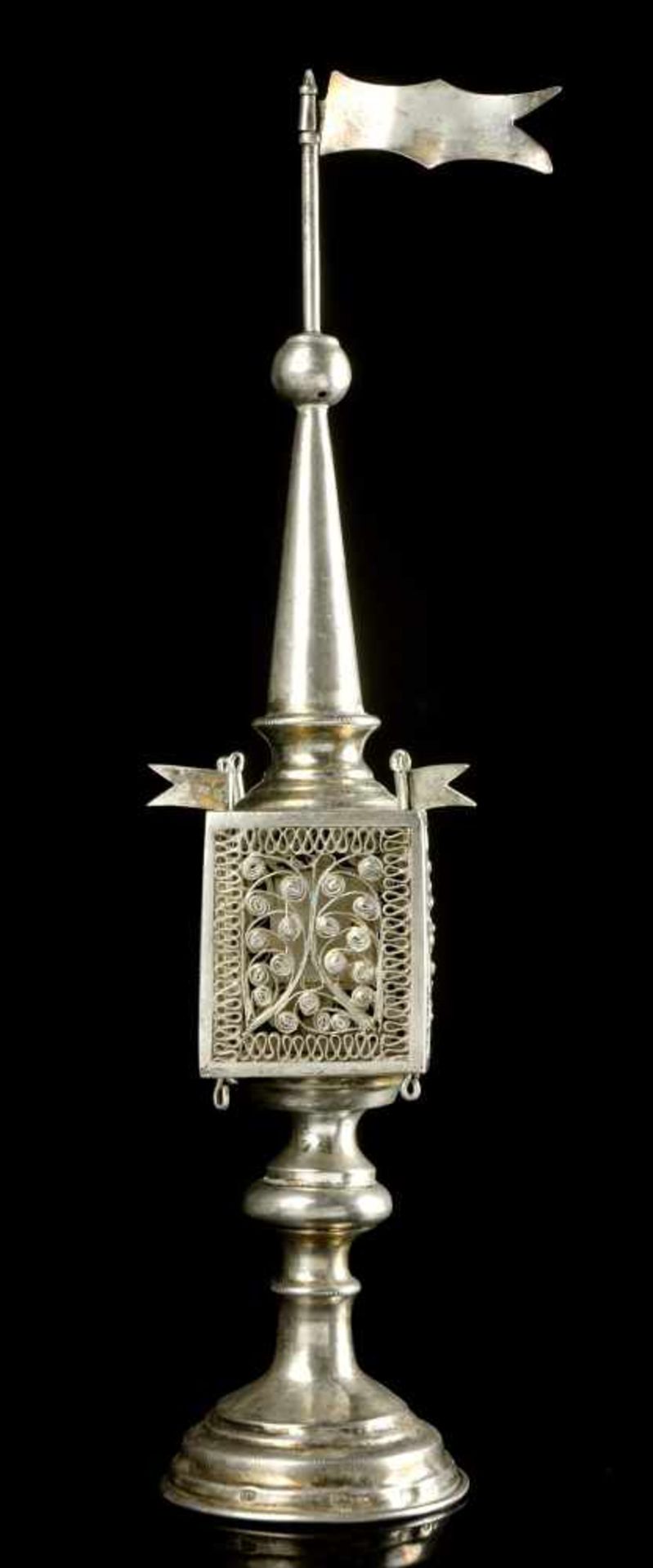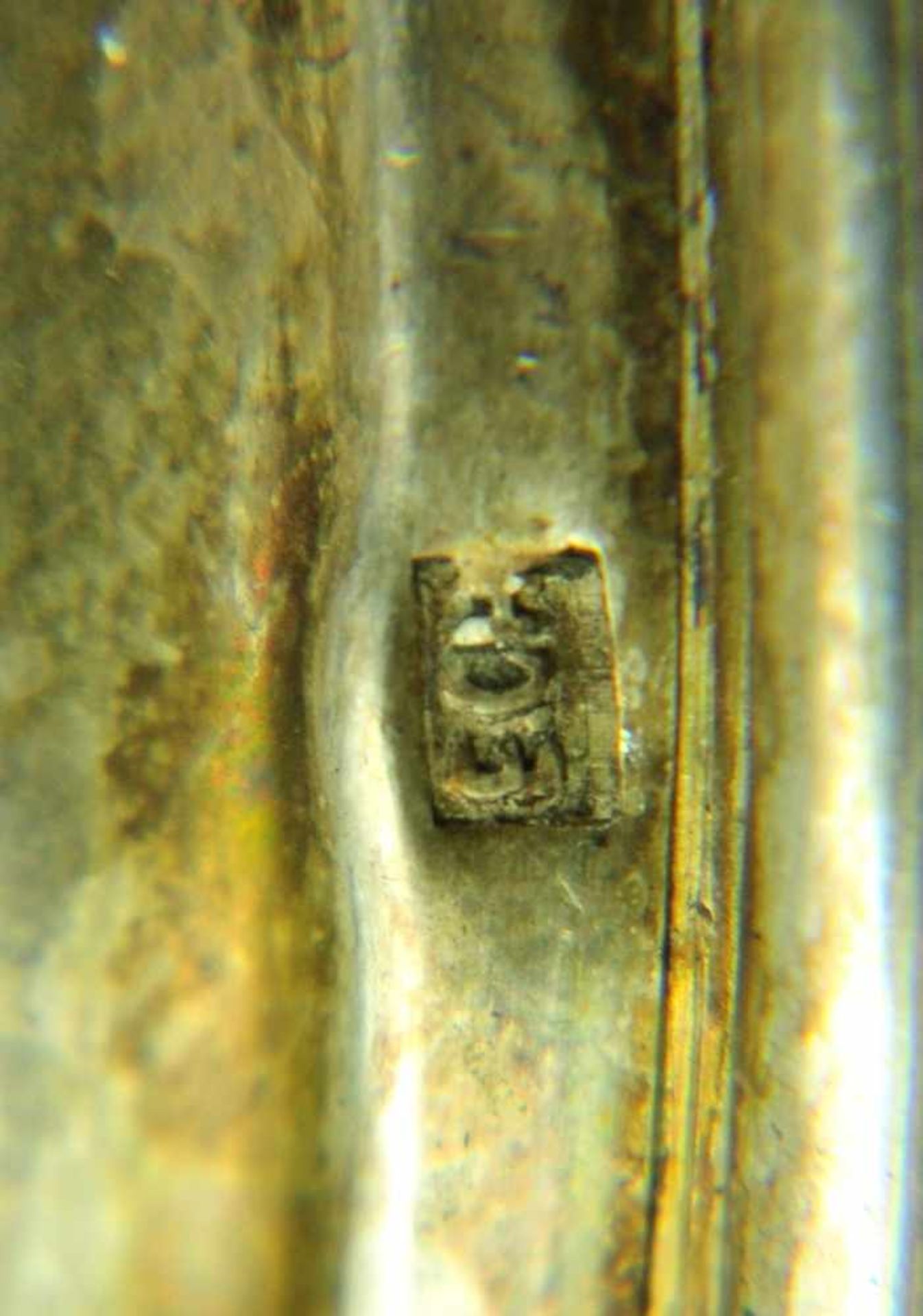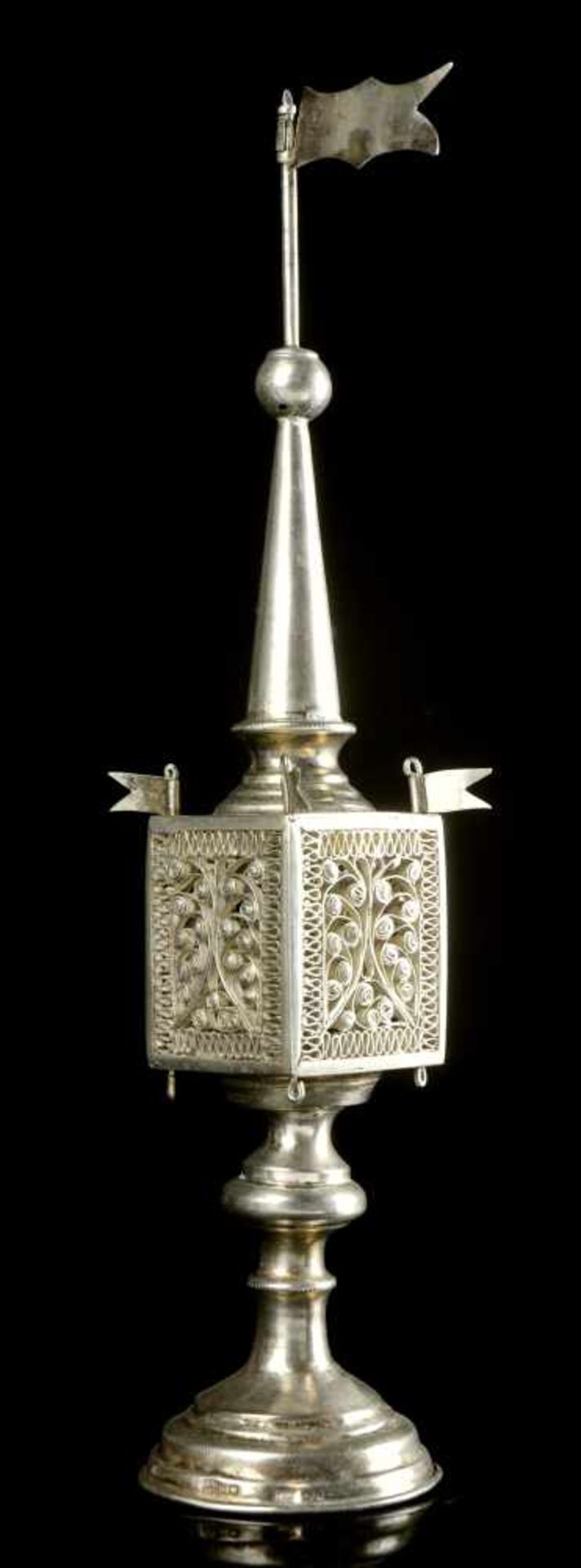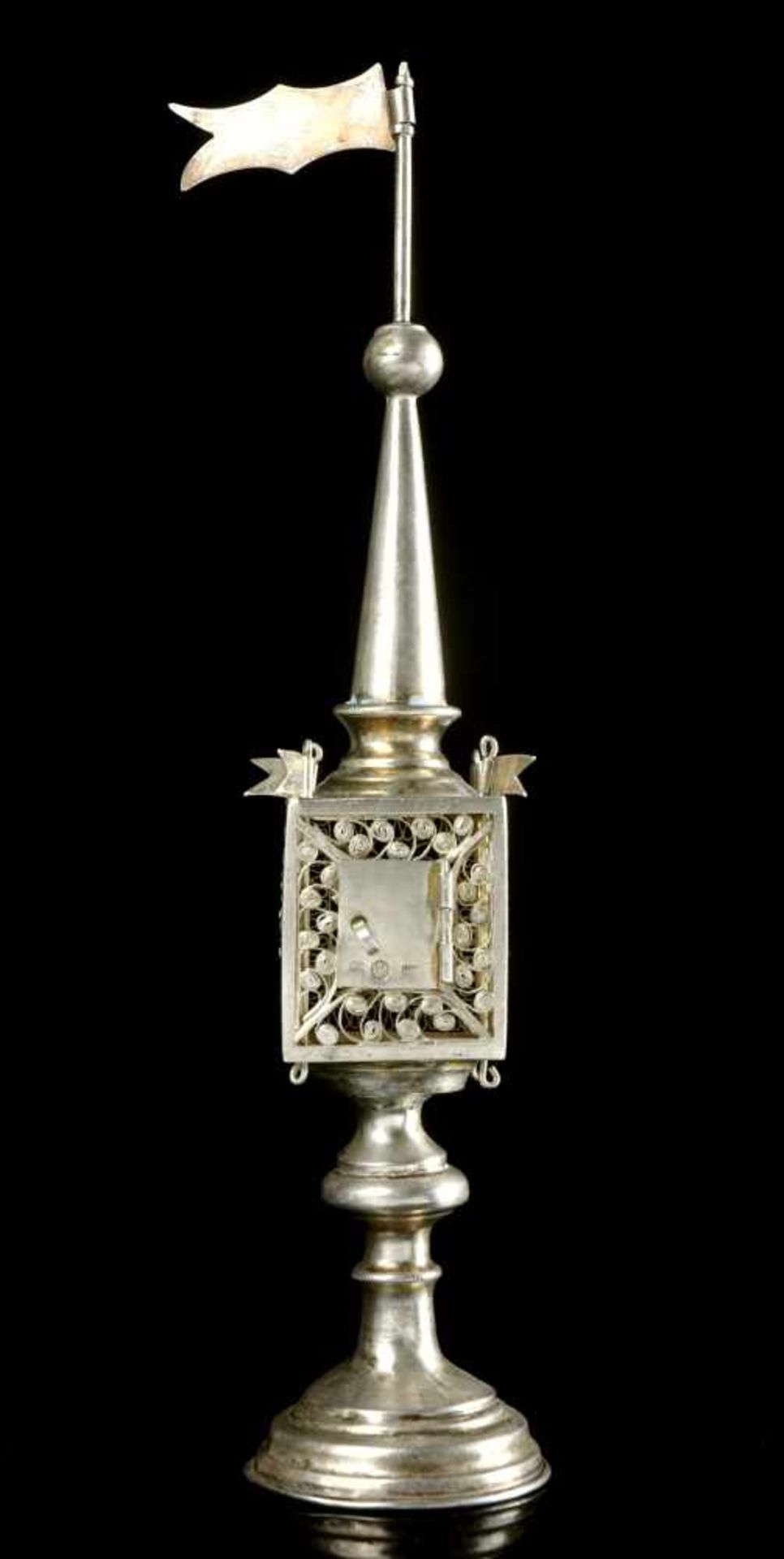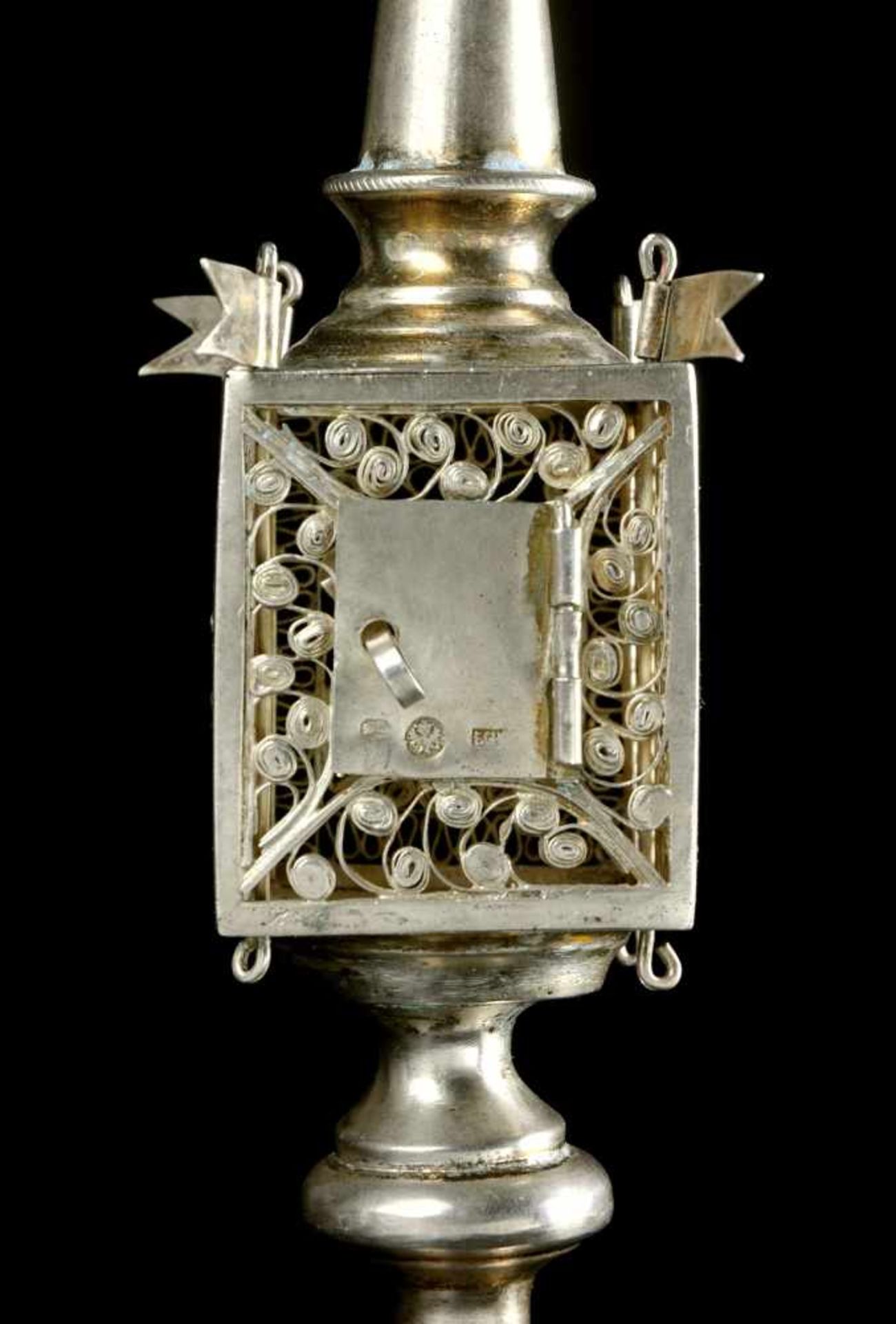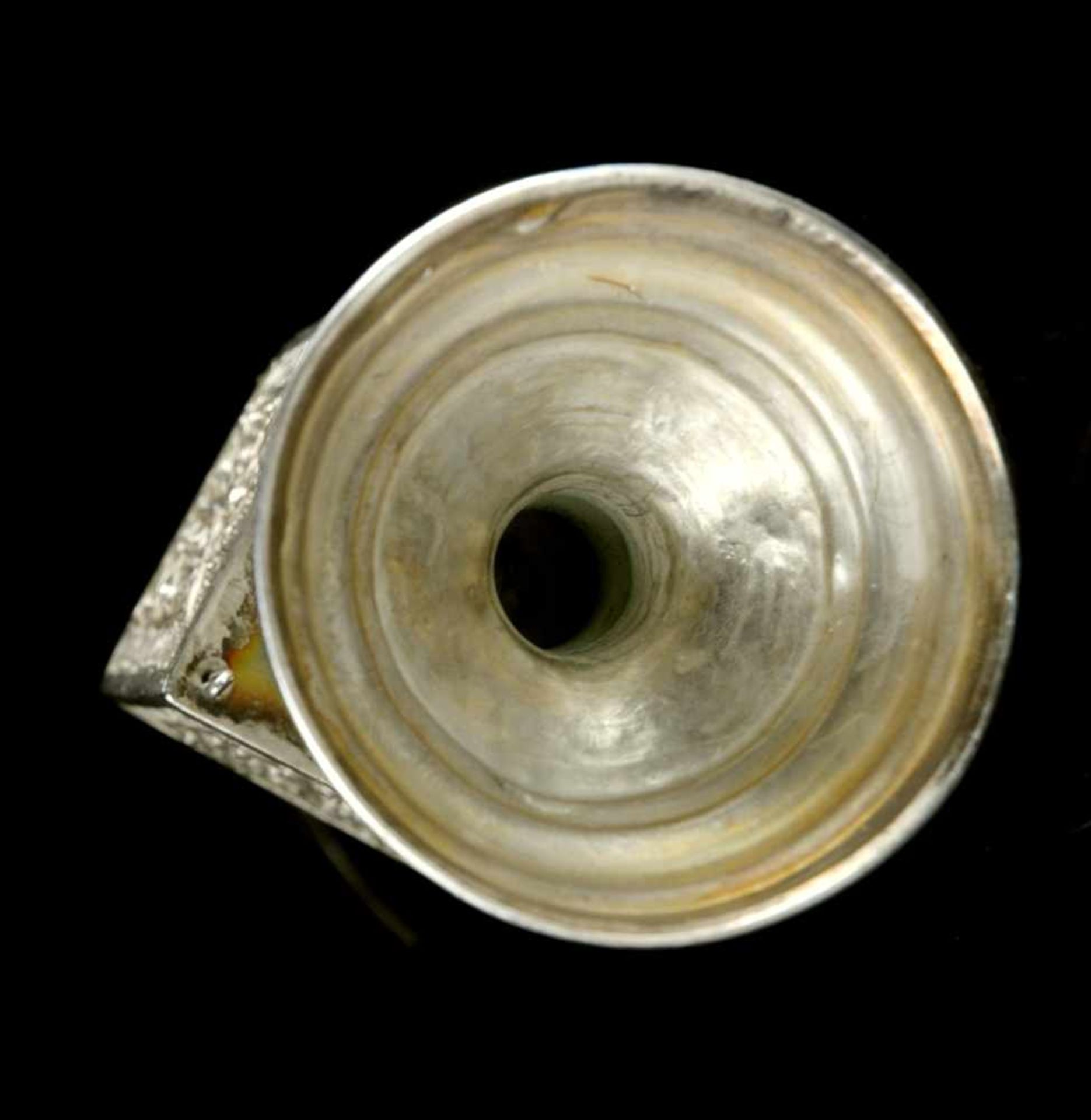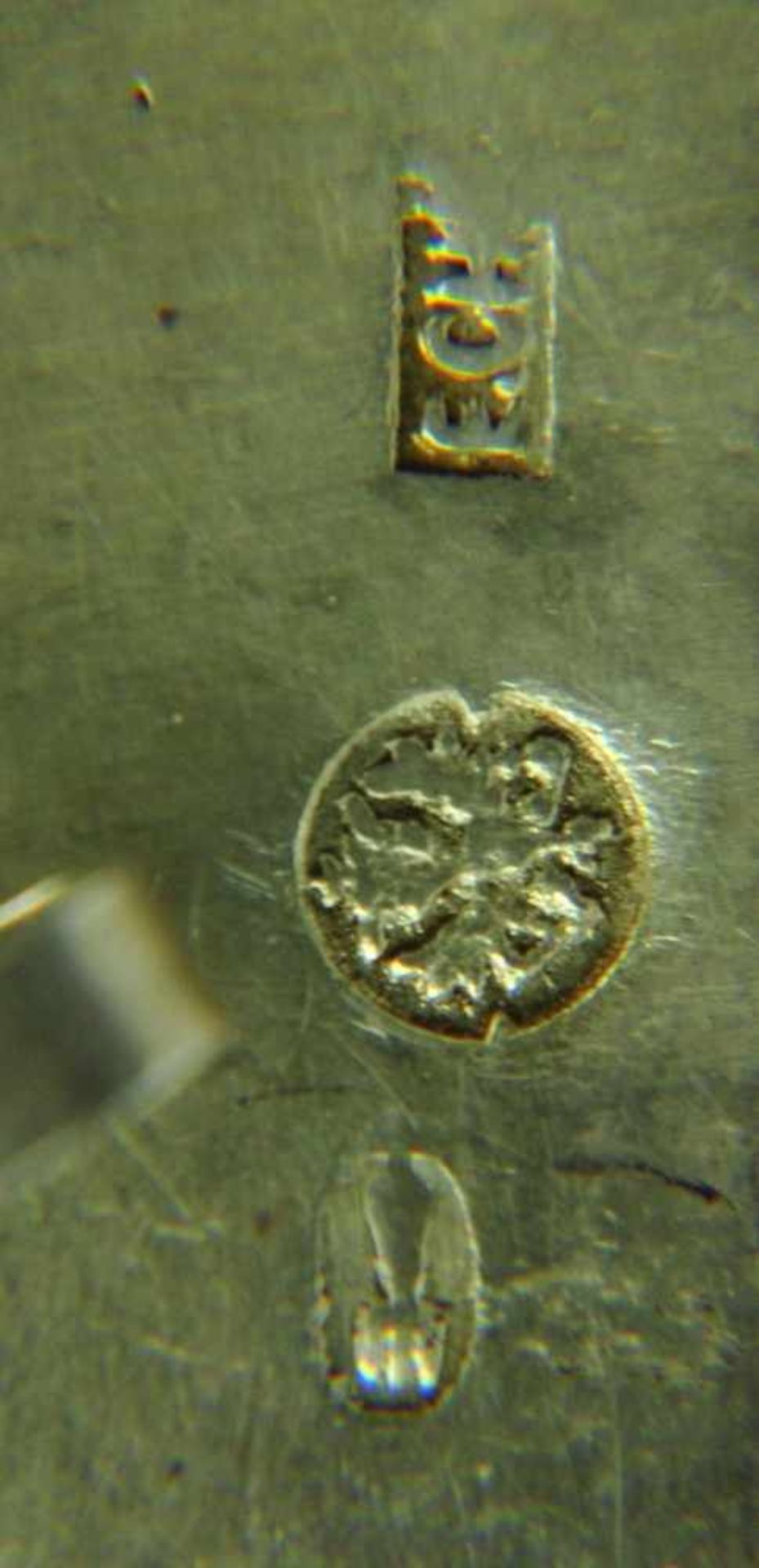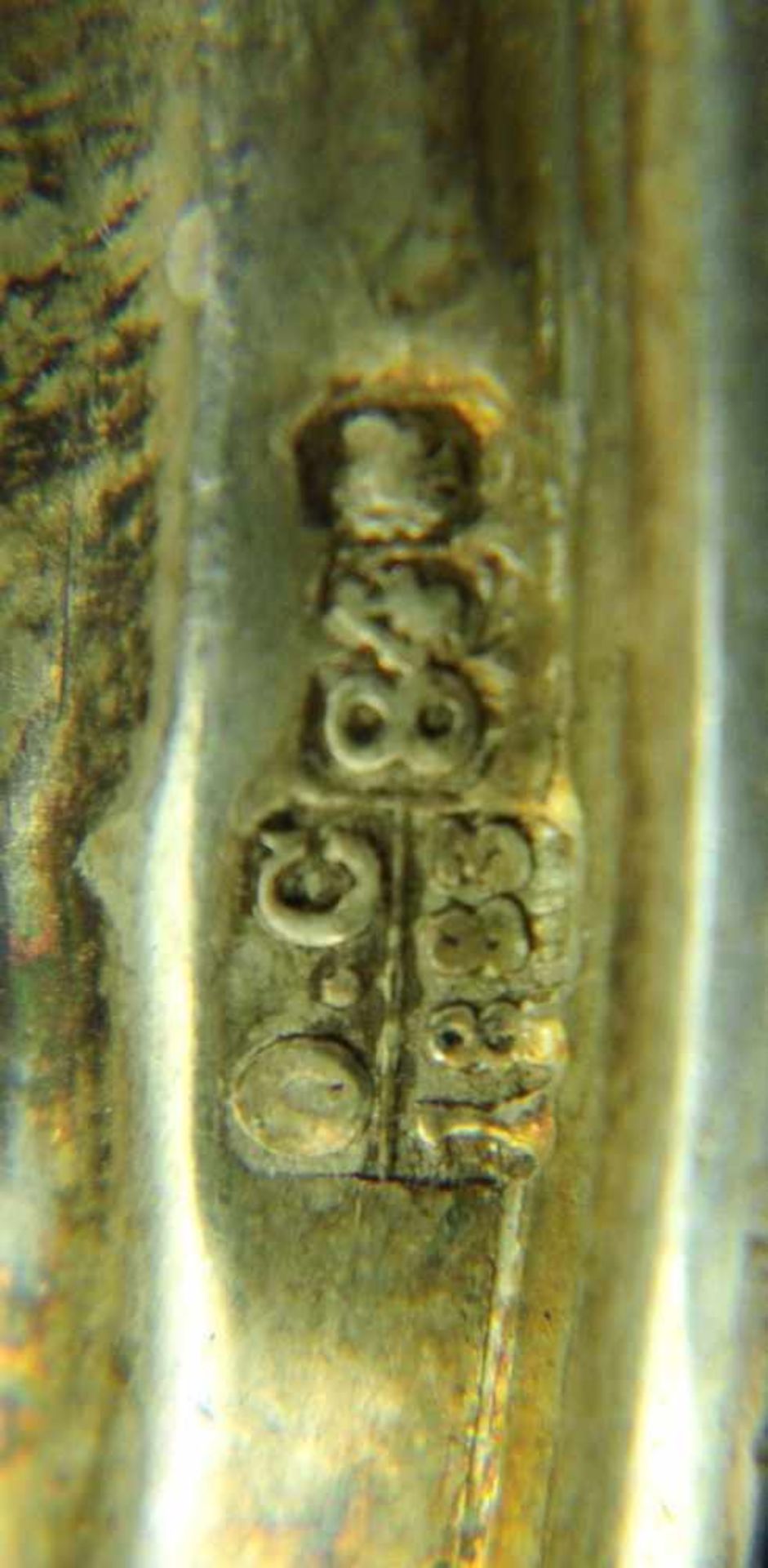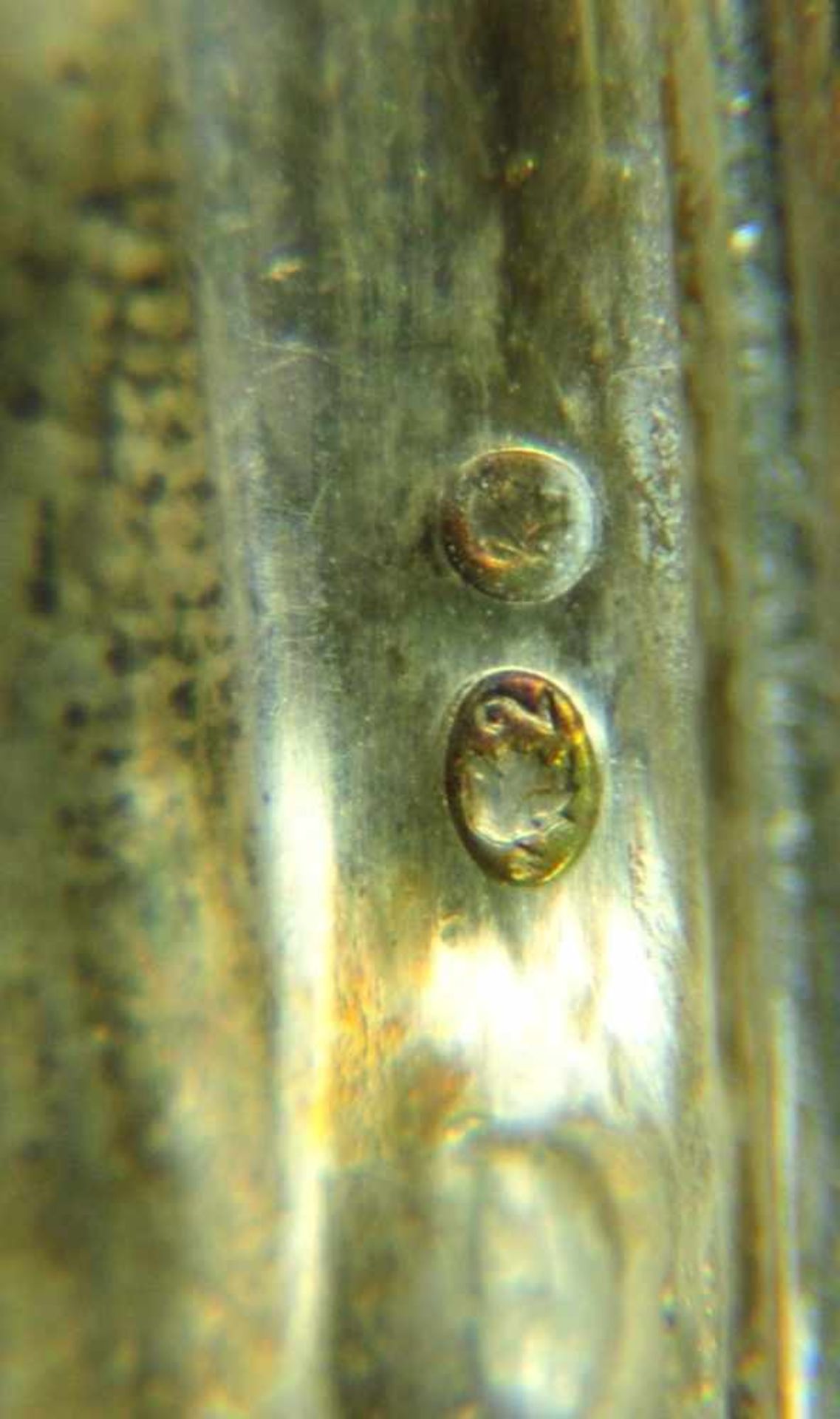29
JUDAICA, IMPERIAL RUSSIAN (POLISH) SILVER SPICE BOX (BESAMIN), RUSSIA/POLAND (?) 1883Silver spice
1/10
Das Auktionshaus hat für dieses Los keine Ergebnisse veröffentlicht
Wien
Beschreibung
JUDAICA, IMPERIAL RUSSIAN (POLISH) SILVER SPICE BOX (BESAMIN), RUSSIA/POLAND (?) 1883
Silver spice box in the shape of strong tower, made of 84 zolotniki (.875 sterling) silver, probably in Warsaw. Set on a circular base without supports, square form spice section hung with bells, fitted with a hinged door, surmounted by a tapering spire with ball and pennant finial.
Besamin boxes—also known as censers or scent boxes or besamin—can take on various forms; the most common ones, however, are tower-shaped besamin boxes, like the one offered. This is the most popular form of spice boxes, widely known as early as the Middle Ages. Its appearance often imitated local architecture, whereas the symbolical point of reference was the Strong Tower, being the Biblical symbol of God. Besamin boxes were usually made of silver, sometimes of other metals and were often decorated with enamel and precious stones. A widely popular technique was fine filigree. The container for fragrant spices (e.g. clove, cinnamon, vanilla, myrtle), the aroma of which is ritually inhaled during the ceremony called Havdalah (in Hebrew: “separation”), to mark the end of the Shabbat on Saturday night.
Made of .875 standard (Russian 84 zolotniki) silver, repousse, chased and engraved.
Dimensions: height – 267 mm, base diameter – 52 cm.
Weight: 180 g
Stamps:
Maker’s mark: unrecognized E.CH or F.CH in rectangle, stamped both on base and doors.
Assayer’s stamp O.C. / 1893 – probably OsipSosnkowski, active in Warsaw 1869-1896.
Guarantee mark for 84 zolotniki silver standard with illegible townhall mark.
Russian double headed eagle in the circle – stamp used by maker’s authorized for Tsar’s court, on the doors.
Unrecognised stamp in oval, on doors only.
Later (1920-1963 period), double Polish stamp used after 1921.
Silver spice box in the shape of strong tower, made of 84 zolotniki (.875 sterling) silver, probably in Warsaw. Set on a circular base without supports, square form spice section hung with bells, fitted with a hinged door, surmounted by a tapering spire with ball and pennant finial.
Besamin boxes—also known as censers or scent boxes or besamin—can take on various forms; the most common ones, however, are tower-shaped besamin boxes, like the one offered. This is the most popular form of spice boxes, widely known as early as the Middle Ages. Its appearance often imitated local architecture, whereas the symbolical point of reference was the Strong Tower, being the Biblical symbol of God. Besamin boxes were usually made of silver, sometimes of other metals and were often decorated with enamel and precious stones. A widely popular technique was fine filigree. The container for fragrant spices (e.g. clove, cinnamon, vanilla, myrtle), the aroma of which is ritually inhaled during the ceremony called Havdalah (in Hebrew: “separation”), to mark the end of the Shabbat on Saturday night.
Made of .875 standard (Russian 84 zolotniki) silver, repousse, chased and engraved.
Dimensions: height – 267 mm, base diameter – 52 cm.
Weight: 180 g
Stamps:
Maker’s mark: unrecognized E.CH or F.CH in rectangle, stamped both on base and doors.
Assayer’s stamp O.C. / 1893 – probably OsipSosnkowski, active in Warsaw 1869-1896.
Guarantee mark for 84 zolotniki silver standard with illegible townhall mark.
Russian double headed eagle in the circle – stamp used by maker’s authorized for Tsar’s court, on the doors.
Unrecognised stamp in oval, on doors only.
Later (1920-1963 period), double Polish stamp used after 1921.
Auktionsdetails
Versand
AGB & Wichtige Informationen
Stellen Sie dem Verkäufer eine Frage
JUDAICA, IMPERIAL RUSSIAN (POLISH) SILVER SPICE BOX (BESAMIN), RUSSIA/POLAND (?) 1883
Silver spice box in the shape of strong tower, made of 84 zolotniki (.875 sterling) silver, probably in Warsaw. Set on a circular base without supports, square form spice section hung with bells, fitted with a hinged door, surmounted by a tapering spire with ball and pennant finial.
Besamin boxes—also known as censers or scent boxes or besamin—can take on various forms; the most common ones, however, are tower-shaped besamin boxes, like the one offered. This is the most popular form of spice boxes, widely known as early as the Middle Ages. Its appearance often imitated local architecture, whereas the symbolical point of reference was the Strong Tower, being the Biblical symbol of God. Besamin boxes were usually made of silver, sometimes of other metals and were often decorated with enamel and precious stones. A widely popular technique was fine filigree. The container for fragrant spices (e.g. clove, cinnamon, vanilla, myrtle), the aroma of which is ritually inhaled during the ceremony called Havdalah (in Hebrew: “separation”), to mark the end of the Shabbat on Saturday night.
Made of .875 standard (Russian 84 zolotniki) silver, repousse, chased and engraved.
Dimensions: height – 267 mm, base diameter – 52 cm.
Weight: 180 g
Stamps:
Maker’s mark: unrecognized E.CH or F.CH in rectangle, stamped both on base and doors.
Assayer’s stamp O.C. / 1893 – probably OsipSosnkowski, active in Warsaw 1869-1896.
Guarantee mark for 84 zolotniki silver standard with illegible townhall mark.
Russian double headed eagle in the circle – stamp used by maker’s authorized for Tsar’s court, on the doors.
Unrecognised stamp in oval, on doors only.
Later (1920-1963 period), double Polish stamp used after 1921.
Silver spice box in the shape of strong tower, made of 84 zolotniki (.875 sterling) silver, probably in Warsaw. Set on a circular base without supports, square form spice section hung with bells, fitted with a hinged door, surmounted by a tapering spire with ball and pennant finial.
Besamin boxes—also known as censers or scent boxes or besamin—can take on various forms; the most common ones, however, are tower-shaped besamin boxes, like the one offered. This is the most popular form of spice boxes, widely known as early as the Middle Ages. Its appearance often imitated local architecture, whereas the symbolical point of reference was the Strong Tower, being the Biblical symbol of God. Besamin boxes were usually made of silver, sometimes of other metals and were often decorated with enamel and precious stones. A widely popular technique was fine filigree. The container for fragrant spices (e.g. clove, cinnamon, vanilla, myrtle), the aroma of which is ritually inhaled during the ceremony called Havdalah (in Hebrew: “separation”), to mark the end of the Shabbat on Saturday night.
Made of .875 standard (Russian 84 zolotniki) silver, repousse, chased and engraved.
Dimensions: height – 267 mm, base diameter – 52 cm.
Weight: 180 g
Stamps:
Maker’s mark: unrecognized E.CH or F.CH in rectangle, stamped both on base and doors.
Assayer’s stamp O.C. / 1893 – probably OsipSosnkowski, active in Warsaw 1869-1896.
Guarantee mark for 84 zolotniki silver standard with illegible townhall mark.
Russian double headed eagle in the circle – stamp used by maker’s authorized for Tsar’s court, on the doors.
Unrecognised stamp in oval, on doors only.
Later (1920-1963 period), double Polish stamp used after 1921.
Militariy Collectables
Auktionsdatum
Ort der Versteigerung
Traubengasse 2/9
Wien
1230
Austria
Für Karabela Auctions Versandinformtation bitte wählen Sie +48 695 112 291.






















